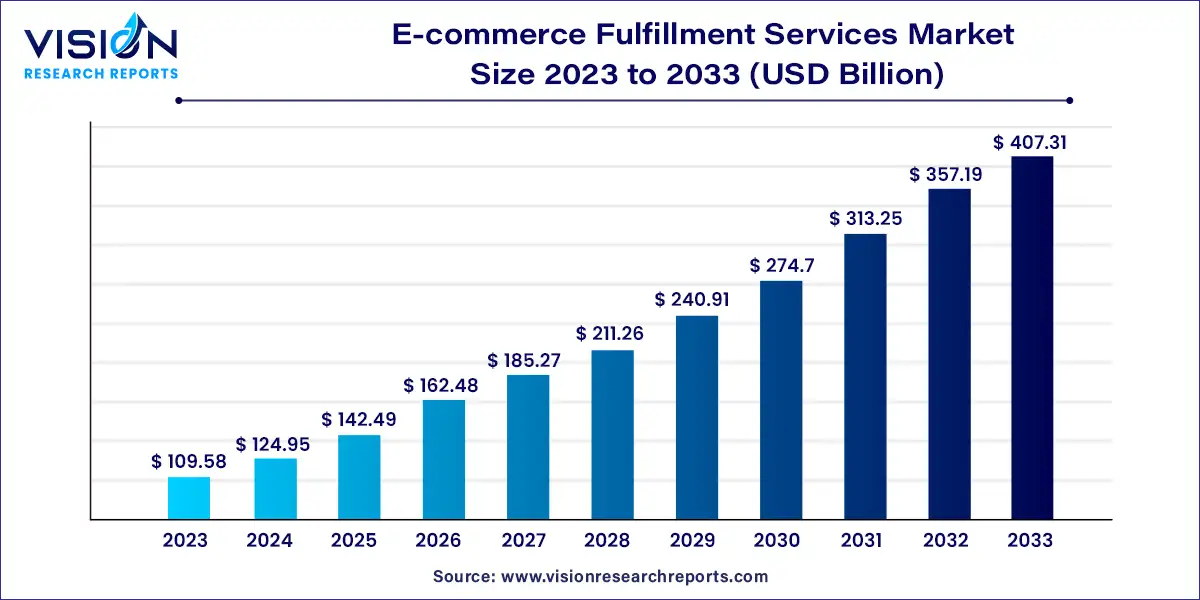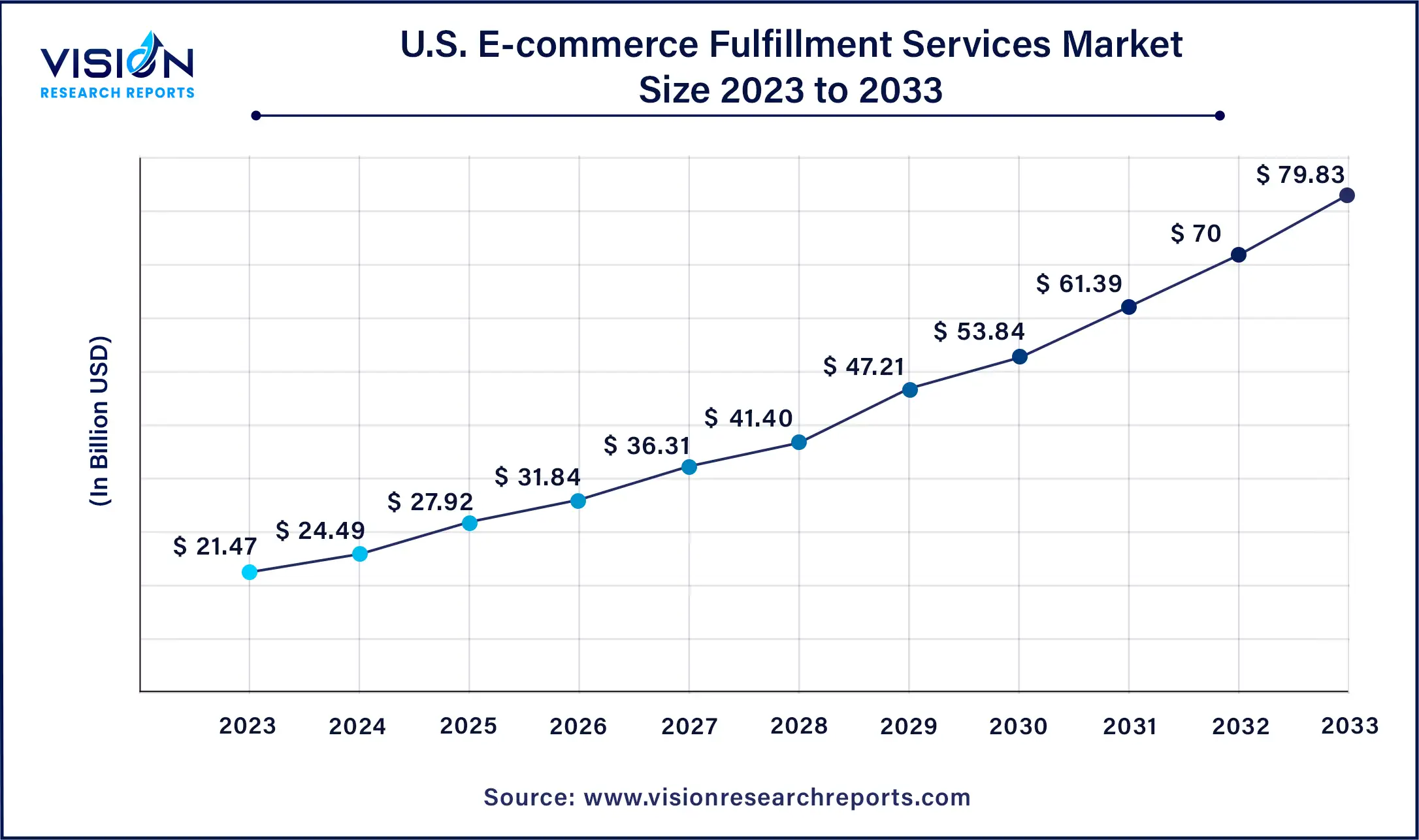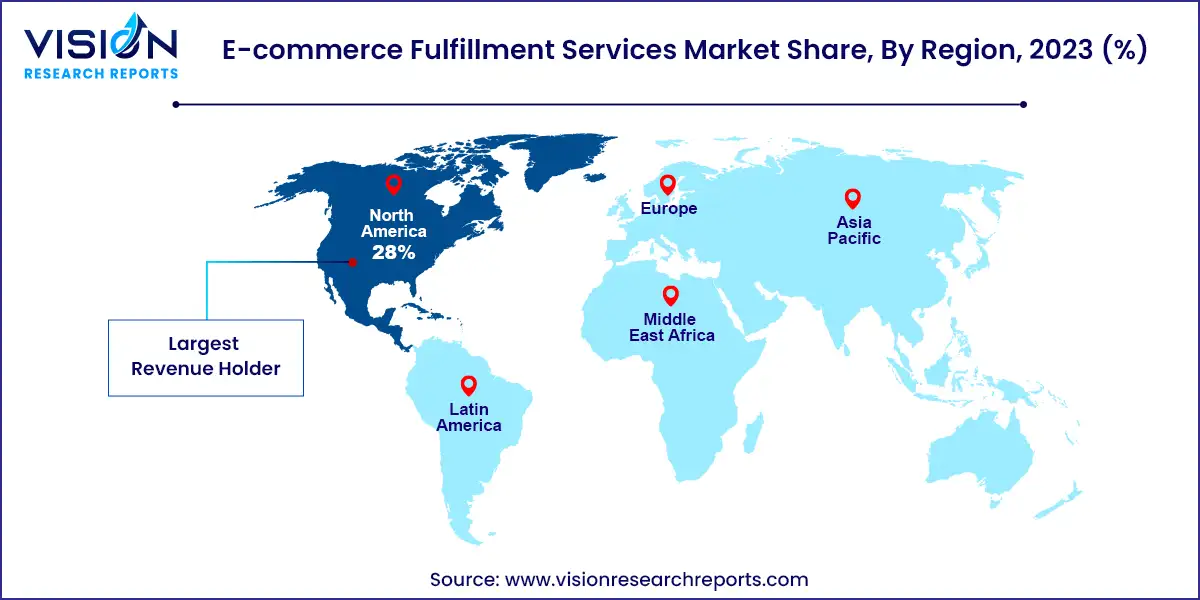The global e-commerce fulfillment services market size was surpassed at USD 109.58 billion in 2023 and is expected to hit around USD 407.31 billion by 2033, growing at a CAGR of 14.03% from 2024 to 2033.

The e-commerce fulfillment services market is experiencing significant growth driven by the rapid expansion of online retail. This sector encompasses a wide range of services aimed at facilitating the storage, packaging, and shipping of products ordered online. Key players in this market include third-party logistics providers (3PLs) and fulfillment centers that specialize in efficiently managing inventory and order fulfillment processes. The increasing demand for quick and reliable delivery services, coupled with advancements in technology such as automation and robotics, are reshaping the landscape of e-commerce fulfillment.
The growth of the e-commerce fulfillment services market is propelled by the exponential rise in online shopping has necessitated efficient and scalable fulfillment solutions. This surge is driven by changing consumer behaviors favoring convenience and the accessibility of a wide range of products online. Additionally, advancements in logistics technology, such as automation, AI-driven analytics, and robotics, have significantly enhanced operational efficiencies within fulfillment centers. These technologies streamline order processing, reduce turnaround times, and optimize inventory management, thereby meeting the growing demand for fast and reliable delivery services. Moreover, the globalization of e-commerce has expanded market reach, prompting businesses to seek reliable fulfillment partners capable of managing international logistics seamlessly.
The U.S. e-commerce fulfillment services market size was estimated at around USD 21.47 billion in 2023 and it is projected to hit around USD 79.83 billion by 2033, growing at a CAGR of 14.03% from 2024 to 2033.

North America dominated the e-commerce fulfillment services market in 2023, capturing the largest revenue share of 28%. The surge in e-commerce is propelling market growth as consumers confidently purchase a wider range of goods online. This is enhanced by the growth of omnichannel retail, where brick-and-mortar stores integrate online elements, allowing for seamless browsing, purchasing, and delivery options. The demand for efficient last-mile delivery solutions, such as same-day delivery and flexible pick-up locations, further drives the market. Additionally, the emergence of social commerce, where social media platforms facilitate direct product discovery and purchase, creates new opportunities. The confluence of rising e-commerce adoption, omnichannel expansion, last-mile delivery demands, and social commerce growth is creating a boom in the North American e-commerce fulfillment services market.

The e-commerce fulfillment services market in the Asia Pacific region recorded the fastest CAGR of 15.13% from 2024 to 2033. Government initiatives, such as infrastructure development and streamlined regulations, actively support e-commerce growth and create a favorable market environment. Further, the surge in e-commerce adoption across the region, particularly among the expanding middle class, is a primary driver. This trend is further supported by the increasing demand for last-mile delivery options as consumers seek faster and more convenient ways to receive their online purchases. Additionally, a growing focus on sustainability is shaping the market, with businesses and consumers prioritizing eco-friendly packaging and fulfillment solutions. These combined forces are driving the Asia Pacific e-commerce fulfillment services market to new heights, necessitating innovative and sustainable solutions to meet the evolving needs of the region's dynamic online economy.
In 2023, shipping fulfillment services led the market with a significant revenue share of 41%. These services, integral to e-commerce operations, manage crucial stages from inventory receipt to the last mile delivery. They are pivotal in ensuring prompt and secure delivery, essential for bolstering customer satisfaction and loyalty amidst intense online retail competition. As e-commerce continues to expand, the demand for efficient shipping fulfillment services is expected to sustain robust market growth.
The bundling fulfillment services segment is anticipated to achieve a notable CAGR of 14.83% during the forecast period. This growth is driven by increasing demand for comprehensive solutions that encompass storage, packaging, and value-added services such as kitting and custom packaging. With the rise of omnichannel retail and personalized product bundles, these services offer cost-effective strategies to manage diverse inventory across platforms, ensuring consistent customer presentation. The segment's expansion reflects its pivotal role in enhancing operational efficiency and customer experience in the evolving e-commerce landscape.
The business-to-business (B2B) segment dominated in 2023, attributed to complex supply chain needs and high-volume transactions. E-commerce fulfillment services cater to these requirements by optimizing warehousing, inventory management, and order fulfillment processes. Specialized services address industry-specific demands, including compliance and labeling for commercial goods. As B2B e-commerce continues to grow, the demand for scalable and efficient fulfillment solutions remains robust, securing the segment's market position.
The direct-to-consumer (D2C) and business-to-consumer (B2C) segment is poised for significant growth, driven by increasing consumer preference for online shopping. E-commerce fulfillment services facilitate streamlined inventory management, order processing, and delivery for individual customer orders. Integration with e-commerce platforms enhances operational efficiency, meeting demands for personalized and expedited shipping options. As consumer expectations evolve, these services are pivotal in supporting the dynamic growth of the D2C/B2C segment.
In 2023, large enterprises commanded the largest market share, leveraging e-commerce fulfillment services to manage high-volume operations and complex supply chains efficiently. Outsourcing fulfillment enables focus on core business functions while ensuring prompt customer delivery, amidst the global surge in online shopping. This trend is anticipated to continue as businesses prioritize operational efficiency and customer satisfaction in an increasingly competitive market environment.
Small and medium enterprises (SMEs) are expected to register significant growth over the forecast period, propelled by the burgeoning online retail sector. E-commerce fulfillment services offer SMEs scalable solutions to compete effectively, optimizing resource allocation for innovation and marketing initiatives. The flexibility and cost-effectiveness of these services make them particularly attractive to expanding enterprises, driving widespread adoption amidst increasing online transactions.
The clothing & footwear segment dominated in 2023, reflecting growing consumer preference for online apparel purchases. E-commerce fulfillment services cater to specific needs such as size variations and presentation-worthy packaging, essential for enhancing customer satisfaction. As online apparel shopping continues to rise, these services are poised to sustain the segment's growth within the market.
The consumer electronics segment is projected to achieve the highest CAGR, fueled by expanding online sales and the convenience of home delivery. E-commerce fulfillment services play a crucial role in ensuring timely and secure delivery of electronics, addressing unique packaging and handling requirements. With increasing adoption by manufacturers and retailers, these services are pivotal in supporting the segment's growth trajectory.
By Service
By Sales Channel
By Organization Size
By Application
By Region
Chapter 1. Introduction
1.1. Research Objective
1.2. Scope of the Study
1.3. Definition
Chapter 2. Research Methodology
2.1. Research Approach
2.2. Data Sources
2.3. Assumptions & Limitations
Chapter 3. Executive Summary
3.1. Market Snapshot
Chapter 4. Market Variables and Scope
4.1. Introduction
4.2. Market Classification and Scope
4.3. Industry Value Chain Analysis
4.3.1. Raw Material Procurement Analysis
4.3.2. Sales and Distribution Channel Analysis
4.3.3. Downstream Buyer Analysis
Chapter 5. COVID 19 Impact on E-commerce Fulfillment Services Market
5.1. COVID-19 Landscape: E-commerce Fulfillment Services Industry Impact
5.2. COVID 19 - Impact Assessment for the Industry
5.3. COVID 19 Impact: Global Major Government Policy
5.4. Market Trends and Opportunities in the COVID-19 Landscape
Chapter 6. Market Dynamics Analysis and Trends
6.1. Market Dynamics
6.1.1. Market Drivers
6.1.2. Market Restraints
6.1.3. Market Opportunities
6.2. Porter’s Five Forces Analysis
6.2.1. Bargaining power of suppliers
6.2.2. Bargaining power of buyers
6.2.3. Threat of substitute
6.2.4. Threat of new entrants
6.2.5. Degree of competition
Chapter 7. Competitive Landscape
7.1.1. Company Market Share/Positioning Analysis
7.1.2. Key Strategies Adopted by Players
7.1.3. Vendor Landscape
7.1.3.1. List of Suppliers
7.1.3.2. List of Buyers
Chapter 8. Global E-commerce Fulfillment Services Market, By Service
8.1. E-commerce Fulfillment Services Market, by Service, 2024-2033
8.1.1. Shipping Fulfillment Services
8.1.1.1. Market Revenue and Forecast (2021-2033)
8.1.2. Warehousing and Storage Fulfillment Services
8.1.2.1. Market Revenue and Forecast (2021-2033)
8.1.3. Bundling Fulfillment Services
8.1.3.1. Market Revenue and Forecast (2021-2033)
8.1.4. Others
8.1.4.1. Market Revenue and Forecast (2021-2033)
Chapter 9. Global E-commerce Fulfillment Services Market, By Sales Channel
9.1. E-commerce Fulfillment Services Market, by Sales Channel, 2024-2033
9.1.1. Business to Business
9.1.1.1. Market Revenue and Forecast (2021-2033)
9.1.2. Direct to Customer/ Business to Customer
9.1.2.1. Market Revenue and Forecast (2021-2033)
Chapter 10. Global E-commerce Fulfillment Services Market, By Organization Size
10.1. E-commerce Fulfillment Services Market, by Organization Size, 2024-2033
10.1.1. Large Enterprises
10.1.1.1. Market Revenue and Forecast (2021-2033)
10.1.2. Small and Medium Enterprises (SMEs)
10.1.2.1. Market Revenue and Forecast (2021-2033)
Chapter 11. Global E-commerce Fulfillment Services Market, By Application
11.1. E-commerce Fulfillment Services Market, by Application, 2024-2033
11.1.1. Clothing & Footwear
11.1.1.1. Market Revenue and Forecast (2021-2033)
11.1.2. Consumer Electronics
11.1.2.1. Market Revenue and Forecast (2021-2033)
11.1.3. Home & Kitchen Application
11.1.3.1. Market Revenue and Forecast (2021-2033)
11.1.4. Beauty & Personal Care
11.1.4.1. Market Revenue and Forecast (2021-2033)
11.1.5. Sports & Leisure
11.1.5.1. Market Revenue and Forecast (2021-2033)
11.1.6. Automotive
11.1.6.1. Market Revenue and Forecast (2021-2033)
11.1.7. Books & Stationery
11.1.7.1. Market Revenue and Forecast (2021-2033)
11.1.8. Healthcare
11.1.8.1. Market Revenue and Forecast (2021-2033)
11.1.9. Others
11.1.9.1. Market Revenue and Forecast (2021-2033)
Chapter 12. Global E-commerce Fulfillment Services Market, Regional Estimates and Trend Forecast
12.1. North America
12.1.1. Market Revenue and Forecast, by Service (2021-2033)
12.1.2. Market Revenue and Forecast, by Sales Channel (2021-2033)
12.1.3. Market Revenue and Forecast, by Organization Size (2021-2033)
12.1.4. Market Revenue and Forecast, by Application (2021-2033)
12.1.5. U.S.
12.1.5.1. Market Revenue and Forecast, by Service (2021-2033)
12.1.5.2. Market Revenue and Forecast, by Sales Channel (2021-2033)
12.1.5.3. Market Revenue and Forecast, by Organization Size (2021-2033)
12.1.5.4. Market Revenue and Forecast, by Application (2021-2033)
12.1.6. Rest of North America
12.1.6.1. Market Revenue and Forecast, by Service (2021-2033)
12.1.6.2. Market Revenue and Forecast, by Sales Channel (2021-2033)
12.1.6.3. Market Revenue and Forecast, by Organization Size (2021-2033)
12.1.6.4. Market Revenue and Forecast, by Application (2021-2033)
12.2. Europe
12.2.1. Market Revenue and Forecast, by Service (2021-2033)
12.2.2. Market Revenue and Forecast, by Sales Channel (2021-2033)
12.2.3. Market Revenue and Forecast, by Organization Size (2021-2033)
12.2.4. Market Revenue and Forecast, by Application (2021-2033)
12.2.5. UK
12.2.5.1. Market Revenue and Forecast, by Service (2021-2033)
12.2.5.2. Market Revenue and Forecast, by Sales Channel (2021-2033)
12.2.5.3. Market Revenue and Forecast, by Organization Size (2021-2033)
12.2.5.4. Market Revenue and Forecast, by Application (2021-2033)
12.2.6. Germany
12.2.6.1. Market Revenue and Forecast, by Service (2021-2033)
12.2.6.2. Market Revenue and Forecast, by Sales Channel (2021-2033)
12.2.6.3. Market Revenue and Forecast, by Organization Size (2021-2033)
12.2.6.4. Market Revenue and Forecast, by Application (2021-2033)
12.2.7. France
12.2.7.1. Market Revenue and Forecast, by Service (2021-2033)
12.2.7.2. Market Revenue and Forecast, by Sales Channel (2021-2033)
12.2.7.3. Market Revenue and Forecast, by Organization Size (2021-2033)
12.2.7.4. Market Revenue and Forecast, by Application (2021-2033)
12.2.8. Rest of Europe
12.2.8.1. Market Revenue and Forecast, by Service (2021-2033)
12.2.8.2. Market Revenue and Forecast, by Sales Channel (2021-2033)
12.2.8.3. Market Revenue and Forecast, by Organization Size (2021-2033)
12.2.8.4. Market Revenue and Forecast, by Application (2021-2033)
12.3. APAC
12.3.1. Market Revenue and Forecast, by Service (2021-2033)
12.3.2. Market Revenue and Forecast, by Sales Channel (2021-2033)
12.3.3. Market Revenue and Forecast, by Organization Size (2021-2033)
12.3.4. Market Revenue and Forecast, by Application (2021-2033)
12.3.5. India
12.3.5.1. Market Revenue and Forecast, by Service (2021-2033)
12.3.5.2. Market Revenue and Forecast, by Sales Channel (2021-2033)
12.3.5.3. Market Revenue and Forecast, by Organization Size (2021-2033)
12.3.5.4. Market Revenue and Forecast, by Application (2021-2033)
12.3.6. China
12.3.6.1. Market Revenue and Forecast, by Service (2021-2033)
12.3.6.2. Market Revenue and Forecast, by Sales Channel (2021-2033)
12.3.6.3. Market Revenue and Forecast, by Organization Size (2021-2033)
12.3.6.4. Market Revenue and Forecast, by Application (2021-2033)
12.3.7. Japan
12.3.7.1. Market Revenue and Forecast, by Service (2021-2033)
12.3.7.2. Market Revenue and Forecast, by Sales Channel (2021-2033)
12.3.7.3. Market Revenue and Forecast, by Organization Size (2021-2033)
12.3.7.4. Market Revenue and Forecast, by Application (2021-2033)
12.3.8. Rest of APAC
12.3.8.1. Market Revenue and Forecast, by Service (2021-2033)
12.3.8.2. Market Revenue and Forecast, by Sales Channel (2021-2033)
12.3.8.3. Market Revenue and Forecast, by Organization Size (2021-2033)
12.3.8.4. Market Revenue and Forecast, by Application (2021-2033)
12.4. MEA
12.4.1. Market Revenue and Forecast, by Service (2021-2033)
12.4.2. Market Revenue and Forecast, by Sales Channel (2021-2033)
12.4.3. Market Revenue and Forecast, by Organization Size (2021-2033)
12.4.4. Market Revenue and Forecast, by Application (2021-2033)
12.4.5. GCC
12.4.5.1. Market Revenue and Forecast, by Service (2021-2033)
12.4.5.2. Market Revenue and Forecast, by Sales Channel (2021-2033)
12.4.5.3. Market Revenue and Forecast, by Organization Size (2021-2033)
12.4.5.4. Market Revenue and Forecast, by Application (2021-2033)
12.4.6. North Africa
12.4.6.1. Market Revenue and Forecast, by Service (2021-2033)
12.4.6.2. Market Revenue and Forecast, by Sales Channel (2021-2033)
12.4.6.3. Market Revenue and Forecast, by Organization Size (2021-2033)
12.4.6.4. Market Revenue and Forecast, by Application (2021-2033)
12.4.7. South Africa
12.4.7.1. Market Revenue and Forecast, by Service (2021-2033)
12.4.7.2. Market Revenue and Forecast, by Sales Channel (2021-2033)
12.4.7.3. Market Revenue and Forecast, by Organization Size (2021-2033)
12.4.7.4. Market Revenue and Forecast, by Application (2021-2033)
12.4.8. Rest of MEA
12.4.8.1. Market Revenue and Forecast, by Service (2021-2033)
12.4.8.2. Market Revenue and Forecast, by Sales Channel (2021-2033)
12.4.8.3. Market Revenue and Forecast, by Organization Size (2021-2033)
12.4.8.4. Market Revenue and Forecast, by Application (2021-2033)
12.5. Latin America
12.5.1. Market Revenue and Forecast, by Service (2021-2033)
12.5.2. Market Revenue and Forecast, by Sales Channel (2021-2033)
12.5.3. Market Revenue and Forecast, by Organization Size (2021-2033)
12.5.4. Market Revenue and Forecast, by Application (2021-2033)
12.5.5. Brazil
12.5.5.1. Market Revenue and Forecast, by Service (2021-2033)
12.5.5.2. Market Revenue and Forecast, by Sales Channel (2021-2033)
12.5.5.3. Market Revenue and Forecast, by Organization Size (2021-2033)
12.5.5.4. Market Revenue and Forecast, by Application (2021-2033)
12.5.6. Rest of LATAM
12.5.6.1. Market Revenue and Forecast, by Service (2021-2033)
12.5.6.2. Market Revenue and Forecast, by Sales Channel (2021-2033)
12.5.6.3. Market Revenue and Forecast, by Organization Size (2021-2033)
12.5.6.4. Market Revenue and Forecast, by Application (2021-2033)
Chapter 13. Company Profiles
13.1. Amazon.com, Inc.
13.1.1. Company Overview
13.1.2. Product Offerings
13.1.3. Financial Performance
13.1.4. Recent Initiatives
13.2. eFulfillment Service
13.2.1. Company Overview
13.2.2. Product Offerings
13.2.3. Financial Performance
13.2.4. Recent Initiatives
13.3. Ingram Micro, Inc.
13.3.1. Company Overview
13.3.2. Product Offerings
13.3.3. Financial Performance
13.3.4. Recent Initiatives
13.4. Rakuten Super Logistics
13.4.1. Company Overview
13.4.2. Product Offerings
13.4.3. Financial Performance
13.4.4. Recent Initiatives
13.5. Red Stag Fulfillment
13.5.1. Company Overview
13.5.2. Product Offerings
13.5.3. Financial Performance
13.5.4. Recent Initiatives
13.6. ShipBob, Inc.
13.6.1. Company Overview
13.6.2. Product Offerings
13.6.3. Financial Performance
13.6.4. Recent Initiatives
13.7. Shipfusion Inc.
13.7.1. Company Overview
13.7.2. Product Offerings
13.7.3. Financial Performance
13.7.4. Recent Initiatives
13.8. Xpert Fulfillment
13.8.1. Company Overview
13.8.2. Product Offerings
13.8.3. Financial Performance
13.8.4. Recent Initiatives
13.9. Sprocket Express
13.9.1. Company Overview
13.9.2. Product Offerings
13.9.3. Financial Performance
13.9.4. Recent Initiatives
13.10. FedEx
13.10.1. Company Overview
13.10.2. Product Offerings
13.10.3. Financial Performance
13.10.4. Recent Initiatives
Chapter 14. Research Methodology
14.1. Primary Research
14.2. Secondary Research
14.3. Assumptions
Chapter 15. Appendix
15.1. About Us
15.2. Glossary of Terms
 Cross-segment Market Size and Analysis for
Mentioned Segments
Cross-segment Market Size and Analysis for
Mentioned Segments
 Additional Company Profiles (Upto 5 With No Cost)
Additional Company Profiles (Upto 5 With No Cost)
 Additional Countries (Apart From Mentioned Countries)
Additional Countries (Apart From Mentioned Countries)
 Country/Region-specific Report
Country/Region-specific Report
 Go To Market Strategy
Go To Market Strategy
 Region Specific Market Dynamics
Region Specific Market Dynamics Region Level Market Share
Region Level Market Share Import Export Analysis
Import Export Analysis Production Analysis
Production Analysis Others
Others